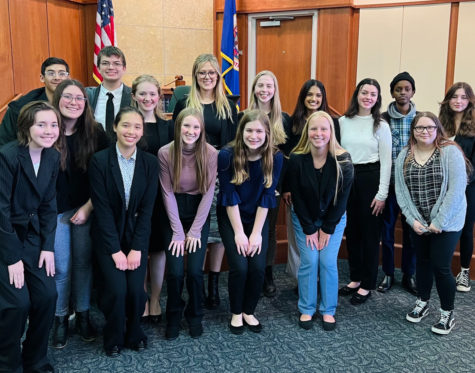Teen Substance Use
A look at national, state and OHS statistics
Editor’s Note: This is a three part series on teens and substance abuse. Part II and III will follow later this week.
Teenagers live with the stereotype of doing drugs. But how many teens are actually using substances? Is the stereotype that all teens do it accurate?
The National Institute on Drug Abuse conducted a survey in December of 2014 of high school substance abuse. The results are summarized in the following table.
Substance Use of Seniors Nationally
| Statistics in 2009 | Statistics in 2014 | |
| Alcohol | 43.5% | 37.4% |
| Tobacco | 11.2% | 6.7% |
| Marijuana | 45% | 49% |
These statistics are about seniors nationwide. The decrease in alcohol consumption has continued for many years. From consumption in 30 days to binge drinking, the percentage of seniors consuming alcohol has steadily decreased from year to year.
Tobacco is a little more complicated. Traditional tobacco use has decreased in the past years. Currently, it is at its lowest point in the history of the study. However, chewing tobacco and e-cigarettes have continued to increase in popularity in the teenage population. According to this same study, marijuana use in seniors has remained relatively steady. The slight increase in the past few years is expected to increase due to the easier access of cannabis and the decrease in the number of teens that think smoking marijuana is harmful.
The Minnesota Department of Health conducts research every year by asking ninth graders a series of questions. The national averages for all high schoolers are computed from these statistics. In 2013, the department put together a comprehensive report of trends regarding alcohol and drug abuse from 1992-2013. The following table will compare the averages.
Substance Use in Minnesota
| Statistics in 1992 | Statistics in 2013 | |
| Alcohol | 64% | 22.9% |
| Tobacco | 18.7% | 7.2% |
| Marijuana | 9.7% | 13.7% |
Reasons for the fluctuation have many origins. The decrease in high school alcohol consumption may be related to stricter consequences in high school athletic arenas, as well as an increased awareness. According to the same research, teens perception of the danger of alcohol has risen. In 2007, more teens than ever thought alcohol consumption was unsafe. In 2013, this number rose again. This trend was also seen in regard to use of tobacco. The 7.2% was the lowest reported high school smoking statistic in the history of the Minnesota Student Survey. The survey also found the use of smokeless tobacco has decreased, as well.
The rate at which teens use marijuana has been raging in the United States since Colorado passed the Colorado Amendment 24, outlining the process for recreational use of cannabis, in November of 2012. Many argue that the drug is now more widely available nationwide, as well. This reason is attributed to the rise in marijuana use in high school students.
While national statistics are interesting, their application is even more so. In the Owatonna High School, students are given a survey their freshman and senior year regarding drug use. The following information is from this survey and compiled by the administration and district staff.
Substance Use in the OHS
| Freshman 2010 (Grade 9) | Senior 2010 (Grade 12) | |
| Alcohol | 37% | 53% |
| Marijuana | 3% | 1% |
| Alcohol and Marijuana | 21% | 41% |
When compared to the state statistics, the Owatonna High School does better in some respects, but also is worse in others. Students Helping Others Choose, also known as SHOC, is an organization that promotes a drug- free lifestyle in the high school and the Owatonna community. SHOC advisor Nancy Williams said, “Within the school, SHOC members are role models for making positive choices and being healthy and safe overall. Within the community, SHOC member promote positive, healthy living by presenting to 5th graders throughout the district the dangers of drugs, alcohol and tobacco and also teach younger students ways to handle peer pressure.”
Owatonna seniors have a much higher percentage of students drinking alcohol than the national averages. And while Minnesota has a much smaller percentage in the nation, the amount of alcohol in the Owatonna High School is extremely high. And while the OHS does not have tobacco statistics, it is safe to assume that less students than usual are using traditional tobacco due to the lowest recorded numbers in the survey.
As for marijuana, the recent debates and new laws regarding this substance are expected to drastically affect the percentage of high schoolers that use marijuana. Nationally, 49% of high school seniors use marijuana. In Minnesota, where medical marijuana is legal, the percentage of students using it is 13.7%. This number is expected to increase due to the legalization of it for medical purposes. At the OHS, the number of people using marijuana varies, with the younger students using more than the older students. Again, these numbers have been projected to increase in the next few years.
[infogram id=”lkYsHioQCjCm4MQ7″]
At OHS, alcohol seems to be the choice substance for most teens. On average, 53% of the senior class consumes alcohol. This means approximately 171 students in a class of 322 use alcohol, over half. In the 2016 graduating class, there are roughly 150-175 student athletes.
According to Minnesota State High School League rules, a student is in violation of the rules if they “use or possess tobacco or alcoholic beverages, use, consume, have in possession, buy, sell or give away any other controlled substance, including steroids, or drug paraphernalia” during their season.
Many in the Owatonna community wonder why there is nothing in Owatonna for teenagers to do. Why is the downtown area not more teen friendly?
While there have been no definite studies, in many communities there has been a correlation between lower substance use and teen centers, or a specific place that caters to the teen population. Perhaps it is time to invest in one for the teens of Owatonna.
Regardless, there are many ways to help teens avoid using any substances. Much of it starts in the family. According to the National Institute on Drug Abuse (NIDA), teens who eat with their family five times a week are 60% less likely to use any substance. NIDA researchers strongly promote the strengthening of family bonds as the best way to prevent substance use. Education is the next best way.
Substance use is a problem nationwide. In the OHS, many of the substance issues can be drastically reduced. It is time to address the situation for what it is- a problem.

I am the editor of Magnet.
I love cows, exact change, and Eeyore.
I am Mrs. Wagner's favorite.







